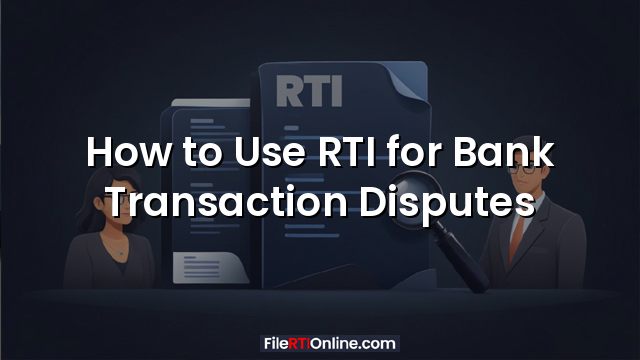How to Use RTI for Bank Transaction Disputes: A Practical Guide
Disputes involving unexplained withdrawals, unauthorised debits, or missing banking records are increasingly common. When internal grievance channels fail, the Right to Information (RTI) Act, 2005 becomes an important tool to seek clarity, verify bank actions, and access transaction-related documents.
This article explains how RTI can be used for bank-related queries and illustrates the limitations of the law through a real case involving a dispute over a Rs. 1 lakh debit from a customer’s bank account.
Why Use RTI for Bank Transaction Issues?
RTI can help you obtain:
- Account statements for periods where irregularities occurred
- Copies of vouchers, authorisation slips, or transaction records
- Details of internal verification or rectification processes
- Status of complaints or steps taken bank
However, RTI is not a substitute for banking grievance mechanisms, and some information may be exempt from disclosure under specific provisions.
Case Example: Seeking Details of a Rs. 1 Lakh Debit
This case before the Central Information Commission (CIC) demonstrates what happens when a bank claims that records are unavailable or exempt.
Background
An appellant filed an RTI application with Sarvve U.P. Gramin Bank seeking information about a transaction in a closed account. He alleged that Rs. 1,00,000/- had been debited without his knowledge and requested details of the withdrawal.
The First Appellate Authority denied the information citing:
- Section 8(1)(d) – commercial confidence
- Section 8(1)(e) – fiduciary relationship
The FAA also claimed the appellant had not proven that he was the account holder.
CIC Proceedings
During the hearing:
- The appellant confirmed that the bank had debited Rs. 1 lakh without authorisation.
- He claimed the money was from a land sale and had been deposited into the account.
- He insisted that the debit entry in his passbook was never authorised .
The bank responded that:
- The transaction was recorded as a transfer on 10-03-2000.
- The account had been closed long ago.
- As per banking norms, vouchers and ledgers are retained only for 8 years, and therefore, records were no longer available.
Because the bank no longer had the relevant documents, it argued that the information could not be furnished.
Decision of the Commission
The CIC upheld the bank’s decision and rejected the appeal.
The Commission accepted that:
- Old banking records were legitimately unavailable due to statutory retention rules.
- The bank could not be compelled to produce records that no longer existed.
- No fault could be found with the PIO for the non-availability of documents.
This case highlights a crucial point: RTI cannot compel a public authority to recreate or retrieve records it no longer holds.
What This Case Teaches Consumers
1. Keep Proof of Account Ownership
RTI applicants must establish a clear link to the account.
Banks can reject the request if identity or ownership is not proven.
2. RTI Cannot Retrieve Records That the Bank Has Destroyed
Banks follow strict record-retention schedules.
Older records—especially from closed accounts—may not be available.
3. RTI Is Not a Substitute for Timely Complaint Filing
If you suspect unauthorised withdrawals, file a complaint immediately.
Waiting for years may lead to permanent loss of relevant records.
4. Use RTI Early to Prevent Evidence Loss
RTI is effective when used promptly to secure copies of:
- vouchers
- ledgers
- audit notes
- internal communications
before they get purged.
How to File an RTI for Bank Transaction Details
Step 1: Identify the Correct Public Authority
RTI applies only to public sector banks such as:
- SBI
- PNB
- Bank of Baroda
- Regional Rural Banks
Private banks do not fall under the RTI Act.
Step 2: Provide Proof of Account Ownership
Attach:
- Copy of passbook
- Aadhaar (masked)
- Any document linking you to the disputed transaction
Step 3: Clearly Mention What You Need
For example:
- Date and details of withdrawal
- Copy of the withdrawal slip
- Record of authorisation
- Ledger entry for the transaction
- CCTV footage (if within retention period)
Step 4: Mention Reason for Seeking Information
Although not mandatory, explaining that it relates to suspected unauthorised debit helps reduce objections.
Step 5: If Records Are Old
Request the bank to confirm:
- Whether such records still exist
- The retention period applicable
- Reasons for non-availability
This avoids ambiguity.
When RTI Will Not Work
RTI cannot help in cases where:
- The bank has destroyed old records as per regulations
- The account holder cannot prove his identity
- The dispute requires adjudication (for example, proving fraud)
- The matter requires compensation or recovery of money
For these issues, you must approach:
- Banking Ombudsman
- Consumer Commission
- Civil Court (if necessary)
Conclusion
RTI is a powerful tool to seek information about bank transactions, but its effectiveness depends on the availability of records, proof of ownership, and timely action.
The Rs. 1 lakh debit case demonstrates that once records are destroyed as per guidelines, the CIC cannot compel their production.
Consumers dealing with disputed withdrawals should use RTI quickly and strategically, while simultaneously pursuing regular banking grievance procedures to ensure effective resolution.


